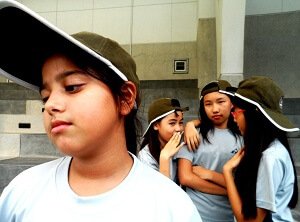 Bullying occurs when people intimidate others through the means of force, threats, or neglect, in order to harm their reputation and social standing and impose their own domination and superiority. Such activities are usually repeated over time and have a habitual nature. While bullying is not limited to certain aggressive behavior of children and adolescents in schools, it is mainly associated with these age groups. There are four main types of bullying which take place in educational institutions and school environments: physical, verbal, covert bullying, and cyberbullying. They are often the main focus of concern for teachers and parents. Below is a brief explanation and possible dangers of each.
Bullying occurs when people intimidate others through the means of force, threats, or neglect, in order to harm their reputation and social standing and impose their own domination and superiority. Such activities are usually repeated over time and have a habitual nature. While bullying is not limited to certain aggressive behavior of children and adolescents in schools, it is mainly associated with these age groups. There are four main types of bullying which take place in educational institutions and school environments: physical, verbal, covert bullying, and cyberbullying. They are often the main focus of concern for teachers and parents. Below is a brief explanation and possible dangers of each.
There is a lot of attention to physical bullying, as it is easily identifiable. It is manifested through punching, hitting, shoving, and other physical actions. Although it is only one of the types, it is usually associated with bullying in general. Sometimes, physical bullying may refer to causing damage to a target person’s property. It is commonly displayed by stronger people against physically weaker ones. Compared to other types, physical bullying is easy to detect and interfere at an early stage.
Similarly to physical bullying, verbal bullying has a clear outward manifestation. It is aimed at humiliation of a target person through words. Its displays include calling the target person names and verbal aggression in general, especially expressed before witnesses. This type of bullying is difficult to prove: adults often don’t believe children and think they tend to exaggerate their hardships. Because of the popular belief that verbal bullying cannot affect children much, its effect is often underestimated.
Covert bullying, or relational aggression, refers to a subtle form of bullying. It includes spreading of rumors, lying about a target person, making them feel unwelcome in a social group, also ignoring, teasing, and mimicking them. There is evidence that girls use hidden bullying more often than boys (the latter prefer physical bullying). As the result of relational aggression, many adolescents feel excluded from their social group and particularly unwelcome in a company of their peers. It might lead to further exclusion in other areas of life, especially if it remains unnoticed by authority figures or ignored.
Cyberbullying is more popular among older adolescents and young people. It occurs when digital technology means are used for the purpose of humiliation and aggression. Bullies attack their victims via the Internet through the use of images, text, or videos. It can encompass all elements of verbal or covert bullying, but also includes imitation of others’ online behavior, anonymous threats, and other forms of psychological pressure that become possible because of anonymity of the offender. It is believed that bullies feel smart and safe online, especially because they can hide behind their virtual personalities. On the other side of the monitor, their victims feel threatened even at home, which increases the stressful effect.
All types of bullying have some common characteristics, which are one’s aim is to gain control over another person or to get the feeling of power. In any type of bullying, targets are chosen by their looks, behavior, or actions — these might be people who act less confident or look weaker or meeker than their peers. Often, bullying targets are young people with special needs or adolescents with an alternative sexual orientation. No matter how or where bullying happens, it should be detected and prevented by people who have the authority to influence or change the aggressive adolescents and to help the excluded ones stand against intimidation efforts of their peers.
References
- Batsche GM, Knoff HM. “Bullies and their victims: Understanding a pervasive problem in the schools.” School Psychology Review, 1994.
- Brank EM, Hoetger LA, Hazen KP. “Bullying.” Annual Review of Law and Social Science, Dec. 2012.
- Cook CR, Williams KR, Guerra NG, et al. “Predictors of Bullying and Victimization in Childhood and Adolescence: A Meta-analytic Investigation.” School Psychology Quarterly. American Psychological Association, 2010.
- Bolton J, Graeve S. No Room for Bullies: From the Classroom to Cyberspace. Boys Town Press, 2005.
- Juvonen J, Graham S. “Bullying in Schools: The Power of Bullies and the Plight of Victims.” Annual Review of Psychology, 2014.
- Williams KD, Forgas JP, Von Hippel W. The Social Outcast: Ostracism, Social Exclusion, Rejection, and Bullying. Psychology Press, 13 May 2013.
- Witted KS. “Student Reports of Physical and Psychological Maltreatment in Schools: An Under Explored Aspect of Student Victimization in Schools.” University of Tennessee, 2005.
